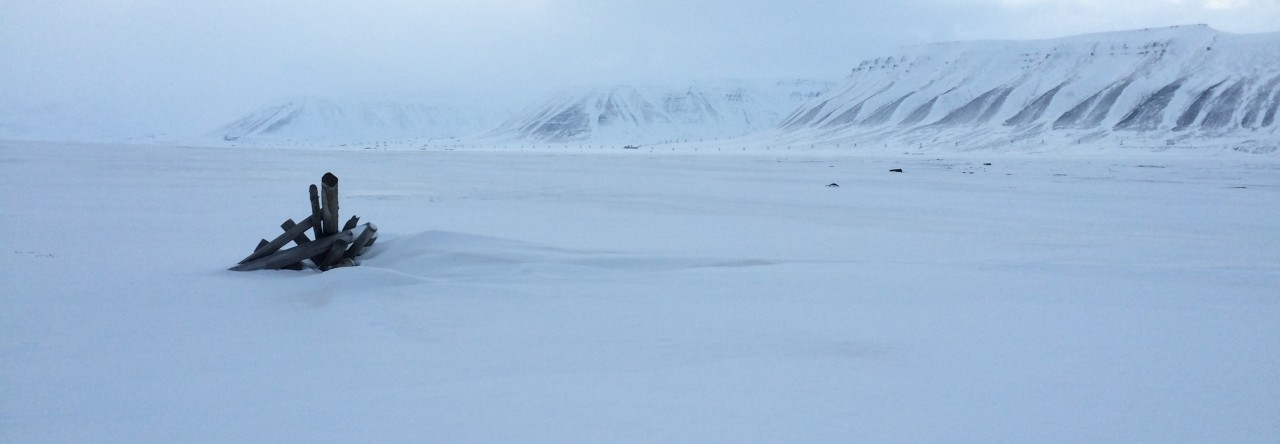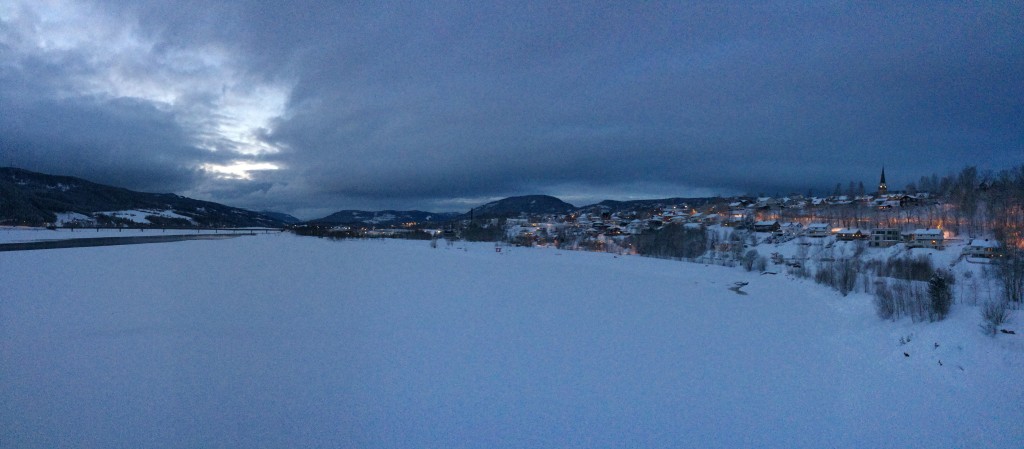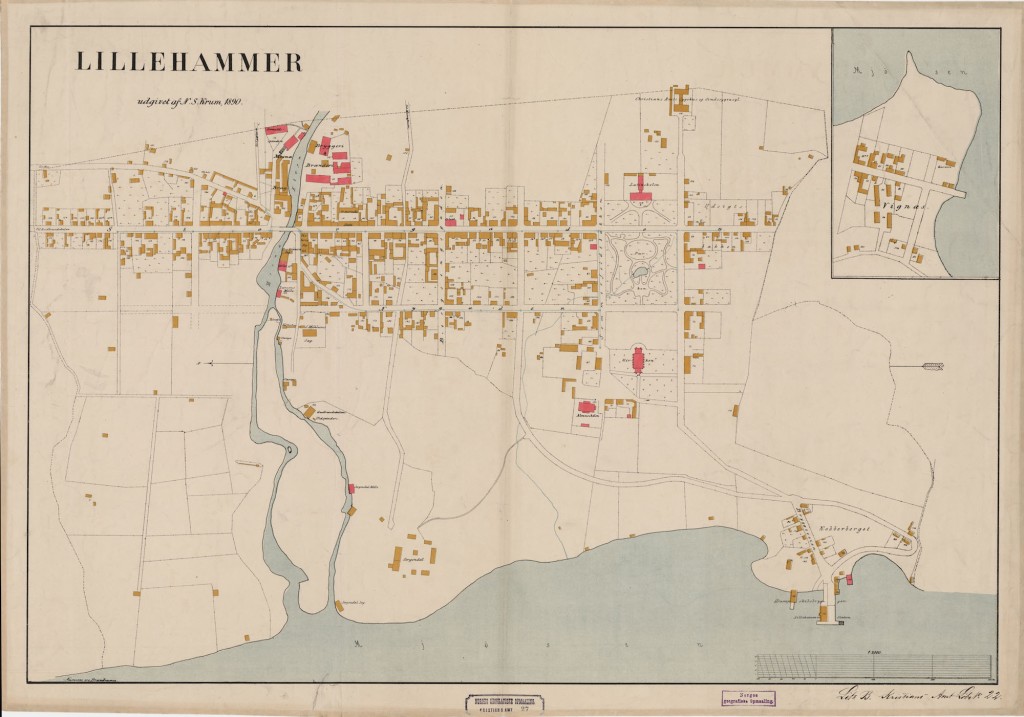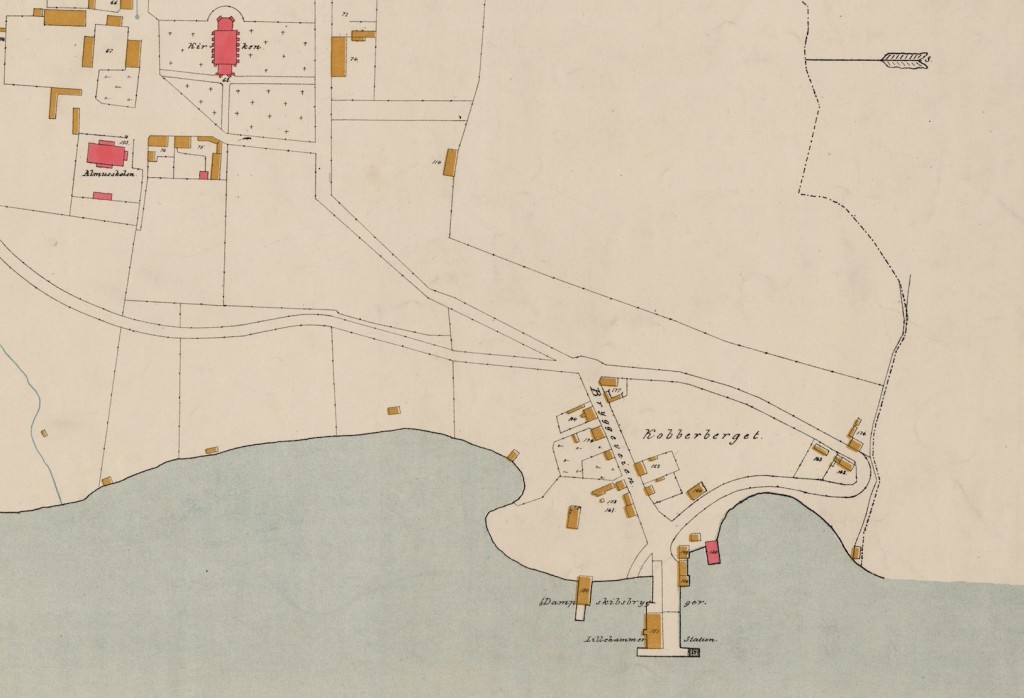From the slopes of Hafjell, looking west across Gudbrandsdalen, one sees the Olympic fakkelmann (torch-bearer) carved by very selective deforestation into the other face the valley. Hafjell was one of the sites of the alpine events for the 1994 Olympic Games in Lillehammer (and the 2016 Youth Olympic Games just a few weeks ago), for which the man was created. I was on skis when I took an image of fakkelmannen, having hauled them along on the train from Oslo and with a free day to spend during a visit to Lillehammer. I wanted to get in some alpine runs before winter disappears from Winterland (the forhold was excellent, by the way). I sent the image to my family. “Did you pretend you were in the Olympics,” asked my dad. (Of course I did!)
I would say there’s something about Lillehammer that gets me, as though I couldn’t quite name it. But I can: Lillehammer is where “the old people” came from. My great-grandfather, Albert Hansen, along with his brother Emil, moved from Lillehammer to Wisconsin in 1906, after their father, Gustav, died. Gustav, my great-great-grandfather, is buried today in the graveyard of Lillehammer Kirke (Lillehammer Church). The rest of the family followed the two brothers some months later. Josephine, my great-great-grandmother, and several of the others, are buried at Deronda Church in Wisconsin, along with my grandfather, bestefaren min, Arvid Myhrwold. Emil Myhrvold (mentioned above) is buried in Puyallup, Washington, south of Seattle. This past summer, a friend and I found that grave. The ‘w’ and ‘v’ in the names Myhrwold and Myhrvold are not typos. When they arrived in Wisconsin, my ancestors changed their name from Hansen to Myhrwold/Myhrvold after the name farm they’d lived on, called Myrvold, and there was no standard spelling, and Norwegians (with apologies to my dear Norwegian readers!) have a little trouble with Vs and Ws. I’ve had some trouble locating that particular farm (there are many Myrvold farms in Norway), though I have a good hunch I’ve located the place in Vestre Toten kommune west of Mjøsa, in the old Ås parish. I’ve found one record in the digitized Norske riksarkivet, the Norwegian National Archives, that mentions the Myrvold farm: the 1895 baptism record of Gustav Hansen, my great-great-uncle, brother to Albert. At that time, my family lived at “Myrvold” (bosted, in the record, means “living place”). But by the time they emigrated to the US, they had moved to a district of Lillehammer formerly called Kobberberget, along the shore of Mjøsa, at the Lillehammer side of the present-day Vingnes bridge. I found this out the day after my recent visit. I’d spent some time in person at the National Archives in Oslo back in September, but the archivist and I couldn’t quite place the farm with certainty. Somehow, here at the beginning of March, I stumbled across the right record, from the 1900 folketelling, the census. But where in town did their homeplace lie? Where was Kobberberget?
I don’t believe in fate, or much at all in the way of what we usually call “supernatural.” Cell memory, maybe—one can’t rule out all the mysteries of the world. But here’s a funny thing: Last week, fellow rover John and I both visited Høgskolen i Lillehammer to give talks on American education to college students studying pedagogy. One evening, before we took dinner, I told John I wanted to head down to the water before the daylight fled and take a couple photographs. He gladly obliged. No destination in mind—I figured only to follow the streets to the lakeshore. We wandered our way to the old iron lattice Vingnes Bridge that crosses Mjøsa. A stroll partway across the span afforded a fine view of Lillehammer clad in in its evening lights, and northward into Gudbrandsdal as the day faded out. But here’s the eerie part: I discovered afterward, by digging up a historical 1890 map of Lillehammer (see below), that the Lillehammer side of Vingnes bridge is precisely the area formerly called Kobberberget. I had unwittingly wandered almost exactly to the front door of the last Norwegian home that (some of) my Norwegian ancestors knew. That’s something! These Hansens (later Myhrwolds) were the most recent of my ancestors to emigrate. My great-grandmother, Cora, who married Albert in Wisconsin, was a “Jerdee,” Americanized from Gjerde by her father, who married a woman with the last name Aasen (these are hard names to track; Aasen means Hill, while Gjerde means Fence—not exactly hard names to come by). But that side of the family was Sogning and emigrated earlier. We don’t know much about their history, though I hope to learn a bit before my own miniature emigration back to Seattle this summer. Thus, Lillehammer is my closest tie to the old country, as it were. It feels good to ply those ways, and such accidents have a certain magic to them, a sort of anchor-point for the play of the mind to find purchase.
The mind is a powerful inventor, to be sure; much of my affection for Lillehammer comes from my affinity to the place. My imagination makes an old world there, superimposed on today’s town, that I can walk through even while I apprehend its present reality. Lillehammer—as any town, any bygd, any tettsted or by—is composed of layers upon layers of all the knots and ties and blood and business, all the building, the tearing-down, the carving and shaping; the works of the lathe, the knife, the plow, the ax; the traces of the animal, the skis, the snow, the melt and the runoff; the wildflowers, the turf, the shoreline, the bridge; the comings and goings, the burials, the births; the undoings and the redoings; all the human feeling and resistance that passes through a place, that pushes up into visible space the surfaces that we perceive in our time. It’s a very old curiosity that animates a place in such a way, that populates it with the energies that have given rise to its being, its multitudes. And to sense that one is somehow a distant echo—or a shadow—of that being, a lapping, in a way, of a wave begun on some ocean-far strand, or the disturbance at the top of a spear of grass that makes visible a wind with some distant origin, long removed—that’s a very strange and very good feeling, with a very particular pleasure in it.
And I’m startled, when I contemplate that pleasure, by the notion that it’s not a pleasure equally distributed. I imagine the manifold, the millions upon millions, whose ties to the “old people” were violently loosed by brutal forces like slavery, who ran—and who run still—from conflict or oppression, out of need in various kinds and degrees. I once got into a friendly argument I didn’t have a chance to finish, but that I’ve thought about often. It was about whether it’s still legitimate to bring slavery, so long abolished, into discussions of inequality and social welfare and equal opportunity. I said yes. My debater said no. Take my family, for instance, which came from Lillehammer with very little. Theirs, like many other Norwegian utvandrer, was hard labor, in harsh land—Minnesota’s winter, North Dakota’s brutal wind—and often with very little knack for farming (Norwegians in Norway were a lot of fisher folk, with a few farmers in the east). The utvandrer to America had to shape a new life in a new land out of little more than what they saw in front of them, what they could learn quickly from their bodily engagement with the unfamiliar. Why should we waste that hard earned reward, the argument goes, on helping those who appear unwilling to work for theirs, who just wait for welfare? But imagine the story my ancestors—with their white skin in the white supremacist America of the 18th and 19th Centuries—could tell their children, and those children theirs: Work hard, you’ll make it. But what story could a slave, and then a former slave, tell their children? “Work hard and—?” Survive. Survive alone. What thoroughgoing reason has our New World civilization given people of color and other marginalized identities to believe in the promises of the land of liberty? (And I mean land here in the most literal sense: many of our Norwegian and Northern and Western European ancestors cashed in mighty easily on the Homestead Act—because their skin color did not automatiaclly cast suspicion on their legitimacy as “full members of this society.”) In short, we have a lot of work to do before we get to celebrate, or even name, our nation as an egalitarian society. And our current electoral “process” suggests pretty clearly we’re not doing a very good job.
And thinking about my own ancestry, and the pleasure it generates to do so, brings into stark relief the privilege I enjoy, especially as I have the double privilege of traveling throughout this landscape of my bloodlines, in a country that has done so much in the last century to build and rebuild its politics and its state around an ethos of social, reciprocal care (though for its embarrassment of alabaster, it doesn’t always get it right, either). But Norway does operate on basic premise of welfare: mutual care, regardless of whether we “like” each other, or think our neighbors “deserve” our tax money. The US constitution insists that we promote the general welfare, though the exorbitant privilege people like me have enoyed can blind us to others’ struggle, or even to their simple needs. I got mine, we say (and some of us out loud), so why should they get some of it? But we forget that in almost every single case, “I” got “mine” in part from someone else, from that uncountable mass of fellow folk, whether friend or fremmed, both now and before. We all pay, but some of us get a bigger check, and more often than not, by little more than luck alone. Privilege is powerful. It is beautiful when it’s felt, and folks ought to be thankful for it. But it’s wildly dangerous when taken thoughtlessly. I’m lucky I landed where I landed, and I have specific people at specific points in history to thank. But really, that sort of luck isn’t shareable. Care, on the other hand, is. And that’s a good thought. A sort of torch to bear.
So, a couple images from my Norwegian hjemsted.

After a foggy all-day in Gudbrandsdalen, the sky half-cleared for a few final runs at Hafjell, fakkelmannen across the valley.




Adina Meyer
I liked the part where you started to sound like Whitman in this one. I didn’t like where you said you “took” dinner. I thought that was pretentious. I think your point about privilege and ancestry is very fine. Did you get that book I sent you?
Scott
Let’s take lunch together this week, Adina!
Andy
Ha! I’m not exactly why I said “took dinner”—it just came out that way. Norwegian is ruining my English. And now that you mention it, it does feel snooty and aloof. Still, I can’t wait to take dinner with you and Scott again. How would Mrs. Frias put it?
Scott
Ah, Emil, RIP
Maria
Excellent & well wrought points about privilege, social responsibility, the truth/reality that fortune depends more on fortuity than on fortitude, and that the legacy of slavery is still relevant to conversations about inequality.
Nathalie Franssen
Beautiful text Andy. I am so glad that you managed to find that place. I was thinking about Eric´s cousins. Their lastname is Skjaeveland and some of them are living in Canada and some in Denmark. For them, it is so powerful to go back to the “tettsted” called Skjaeveland and know that their name comes from there! I can´t help to think about all the others who have no clue about where they do come from, or the ones who cannot go back to where they come from. I feel that Eric´s family is really priviledged 🙂 My father is interested in genealogy as well and tried to trace our family roots. Apparently, we descend from a tramp who was convicted from theft in the area of Bordeaux, in France, and had to flee to Belgium in the 1700´s 🙂
Frøys Hindar
So interesting to read from a Norwegian´s point of view, well, not only a Norwegian, but a distant member of your family, Frøys Hindar, Kaleb Hindar´s oldest son.
I had the pleasure of meeting with Arvid and Adeline visiting us earlier in Norway. Arvid pointed out to us a huge old building – maybe 3 -4 floors building- on the right side of the road leading down to the Skiblander key. He told us that this was the place where his forefathers used to live. The building does not exist any more, but I think I took a picture of it. If I find it, I will send it to you.
On my website hi-henriksen. no look up “Kalebs slekt/ Sør-Amerika reise”. On page 11 you can read some comments on Kopperberget which is exactly where this building I refer to is located.
My very best wishes
Frøys Hindar
Frøys Hindar
Sorry for two mistakes: The website´s name is hindar-henriksen.no
The name of Norway´s oldest ferry / paddle steamer on lake Mjøsa is Skibladner